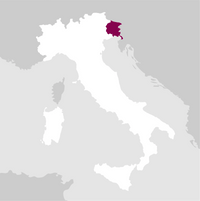Description
Pinot Grigio, the most famous Italian wine in the world, has been cultivated for centuries in Friuli-Venezia Giulia with results of great expressive intensity in hilly terrain, where the wine acquires intense aromas and good concentration.
Awards
Details

Perfume

Color

Taste
Serve at:
08 - 10 °C.
Longevity:
03 - 05 years

Pairings
- Start up year: 1972
- Oenologist: Enrico Raddi
- Bottles produced: 240.000
- Hectares: 74
In the Colli Orientali del Friuli, and especially in Torre Rosazza, the growing of grapevines has a very ancient history. Already known in Roman times, grapes were also grown in the Middle Ages, along with other crops such as olives and grains. In those years, wine was a commodity or a bargaining chip that demonstrated a family’s wealth.
Noble elegance. The history of Torre Rosazza has been tied to the Antonini family, part of the Udine nobility, since the 1600s. Already the lords of the agricultural estate, the Antonini restored the medieval tower and built the villa that became their home in the hills: Turris Rosacea.
After the Antonini, Torre Rosazza passed to the De Marchi family. But more than any other event, the biggest mark on its history was left by the two World Wars. After the Battle of Caporetto, the estate came under Austrian control before returning to Italy at the end of the war. During the World War II it was the scene of fighting between the German occupation army and the Italian Resistance. Read more


| Name | Torre Rosazza Pinot Grigio 2023 |
|---|---|
| Type | White green still |
| Denomination | Colli Orientali del Friuli DOC |
| Vintage | 2023 |
| Size | 0,75 l |
| Alcohol content | 12.5% by volume |
| Grape varieties | 100% Pinot Grigio |
| Country | Italy |
| Region | Friuli-Venezia Giulia |
| Vendor | Torre Rosazza |
| Origin | Manzano (Udine) |
| Climate | Altitude: 120 70 m. a.s.l. |
| Soil composition | Marly and eocenic. |
| Cultivation system | Guyot. |
| Plants per hectare | 4,500 vines per hectare |
| Yield per hectare | About 7,000 kg/hectare. |
| Wine making | Whole grapes are placed in the press, where they are softly squeezed. The vinification is in white, immediately separating the skins from the musts, in steel vats at controlled temperatures. |
| Aging | Partial malolactic fermentation is then carried out and the wine remains in yeast-filled steel containers for 6 months. It is then bottled and left to rest for two more months. |
| Allergens | Contains sulphites |






